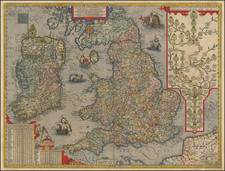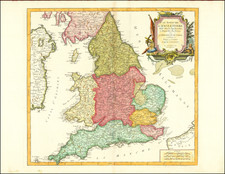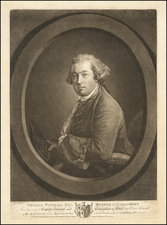Fine mezzotint view of William Stukeley, one of England's great antiquarians.
Portrait of William Stukeley, half length in an oval frame, wearing wig, cravat with fringed ends, and coat; coat of arms below, with motto 'Si sit prudentia'.
William Stukeley (1687 – 1765) was an English antiquarian, physician, and Anglican clergyman. Stukeley pioneered the scholarly investigation of the prehistoric monuments of Stonehenge and Avebury in Wiltshire.
Born in Holbeach, Lincolnshire, Stukeley worked in his father's law business before attending Bene't College, Cambridge. In 1709, he began studying medicine at St Thomas' Hospital, Southwark, before working as a general practitioner in Boston, Lincolnshire.
From 1710 to 1725, Stukeley toured the countryside, seeking out archaeological monuments and other features that interested him, which resulted in several published accounts of his travels.
In 1717, he returned to London and established himself within the city's antiquarian circles. In 1718 he was elected a Fellow of the Royal Society and became the first secretary of the Society of Antiquaries of London. In 1721, he became a Freemason and in 1722 co-founded the Society of Roman Knights, an organisation devoted to the study of Roman Britain. In the early 1720s, Stukeley developed a particular interest in Stonehenge and Avebury, two prehistoric stone circles in Wiltshire. He visited them repeatedly, undertaking fieldwork to determine their dimensions.
In 1726 Stukeley relocated to Grantham, Lincolnshire, where he married. In 1729 he was ordained as a cleric in the Church of England and appointed vicar of All Saints' Church in Stamford, Lincolnshire. He was a friend of the Archbishop of Canterbury William Wake, who encouraged him to use his antiquarian studies to combat the growth of deism and freethought in Britain. To this end, Stukeley developed the belief that Britain's ancient druids had followed a monotheistic religion inherited from the Biblical Patriarchs; he called this druidic religion "Patriarchal Christianity". He further argued that the druids had erected the stone circles as part of serpentine monuments symbolising the Trinity. He was instrumental in British scholarship's acceptance of Charles Bertram's forged Description of Britain. A friend of Isaac Newton, he was also among Newton's first biographers. In 1747 he returned to London as rector of St George the Martyr, Holborn.
He has been described as "probably ... the most important of the early forerunners of the discipline of archaeology" for his practice of personally visiting and examining ancient sites. He has since become the subject of multiple biographies and academic studies.









![[English Channel] De Cust van Vlaenderen en Engelandt van Oostende tot deur de Hoofden](https://storage.googleapis.com/raremaps/img/small/75243.jpg)

![[Fifteen Admiralty Charts of the South Coast of England]](https://storage.googleapis.com/raremaps/img/small/92093.jpg)
![Afteekening van het Margat en Noord Voor Land Digt by de Hoofden, synde de Zuyd Hoek van de Rivier van Londons inkomst [and] Afteekening van de Rivier Cly en Blackeny, geleegen Aan de Oos Kust van Engeland, benoorden Jarmouth](https://storage.googleapis.com/raremaps/img/small/85218.jpg)

